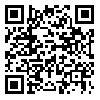Volume 25, Issue 1 (2018)
EIJH 2018, 25(1): 52-66 |
Back to browse issues page
Download citation:
BibTeX | RIS | EndNote | Medlars | ProCite | Reference Manager | RefWorks
Send citation to:



BibTeX | RIS | EndNote | Medlars | ProCite | Reference Manager | RefWorks
Send citation to:
Fattahizadeh F, Zakeri M. Kāshif al-Ghiṭā's Methodology in Criticism of New Testament (Christianity (. EIJH 2018; 25 (1) :52-66
URL: http://eijh.modares.ac.ir/article-27-44325-en.html
URL: http://eijh.modares.ac.ir/article-27-44325-en.html
1- Professor of Qur’anic Sciences & Hadith, Faculty of Theology, Alzahra University, Tehran, Iran
2- MA Student in Qur’anic Sciences & Hadith, Faculty of Theology, Alzahra University, Tehran , Iran zakeri@student.alzahra.ac.ir
2- MA Student in Qur’anic Sciences & Hadith, Faculty of Theology, Alzahra University, Tehran , Iran zakeri@student.alzahra.ac.ir
Abstract: (716 Views)
This paper explores the method Allāmeh Muhammad Husayn Kāshif al-Ghiṭā, a famous Muslim theorist of the 18-19th centuries, employed in his critique of Christianity. Although, his method for looking into the Bible is similar to that of Christian and Jewish scholars, his assumptions and results are different. Based on his viewpoints on the Bible, he believes in impeccable revelations. He examined superstructure, namely accuracy of attribution of books and pamphlets to their authors as well as personality and credibility of Jesus Christ’s disciples and apostles. Lack of credibility of the twelve original disciples of Jesus Christ and unreliability of the Gospels are proved. Moreover, he has carefully examined the content as infrastructure of the New Testament. As such, incongruities can be observed between the New Testament and the Old Testament. There are contradictions in the Bible itself. He prefers to apply argumentative tactic for general readers. In addition, his application of comparative step in his critique is considerable. This paper studies Kāshif al-Ghiṭā's approach to review the Bible in order to figure out Muslim scholars' viewpoints on the Christianity.
Article Type: Original Research |
Subject:
Arts and Humanities (General)
Received: 2020/07/10 | Accepted: 2018/12/15 | Published: 2018/12/15
Received: 2020/07/10 | Accepted: 2018/12/15 | Published: 2018/12/15
Send email to the article author
| Rights and permissions | |
 |
This work is licensed under a Creative Commons Attribution-NonCommercial 4.0 International License. |







